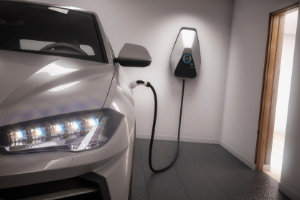Sustainable Living & Sustainable Lifestyle
With electric car sales on the rise, the next logical step is finding out if there’s a battery that can also power your house.
With electric car sales on the rise, the next logical step is finding out if there’s a battery that can also power your house.
 Anyone who has lived through a busy storm season knows how much of a pain power outage can be for a household. For owners of electric cars, exciting new technology can help make power outages a breeze with a solution called bidirectional charging that can allow an electric car battery to power a house.
Anyone who has lived through a busy storm season knows how much of a pain power outage can be for a household. For owners of electric cars, exciting new technology can help make power outages a breeze with a solution called bidirectional charging that can allow an electric car battery to power a house.
Demand for electric vehicles has been growing at a fast pace recently, with new electric vehicle sales almost doubling in the United States in 2021. Projections show that electric vehicles are poised to almost double in the U.S. again in 2022, with 1.2 million units expected to sell by the end of the year.
Future projections look even brighter, with auto industry experts predicting that by the end of the decade, electric vehicles may account for at least half of all new car sales in the U.S. Environmental consideration and the recent surge in gas prices are some of the reasons why a drove of new consumers are seeking out electric vehicle options. It also can serve as a backup source of energy, allowing people to use an electric car battery to power a house.
As many areas of the U.S. have faced widespread power outages in recent years, the ability to use an electric vehicle as a backup power source for their homes is another benefit Americans may be able to enjoy soon.
In theory, electric vehicles already have enough stored energy to power a home for a few days. However, transferring that energy from the electric vehicle back into the house is the key to making this feature work.
Vehicle-to-home charging requires the right batteries and the right equipment. The battery needs to be strong enough to store enough electric fuel to transfer to the home. Based on the number of kilowatt-hours of the vehicle, one can determine how much energy would be needed to power a home.
For example, one kilowatt-hour can power an average refrigerator for five hours, while about 30 kilowatt-hours can power an average home for a day.
Most electric vehicles easily have the battery power needed to provide energy to a home, but that’s only part of the story. The electric vehicle battery also needs to be able to have the right amount of power output in backup power mode, as that is what determines how many appliances the battery could power at once.
Even if an electric vehicle’s battery has the energy needed to power a house, it would still need a bidirectional charger to be able to pull the energy from the battery and into the house. So, for interested consumers, they would need to make sure the electric vehicle is compatible with vehicle-to-home charging, then they would need to purchase the bidirectional charger and get it installed.
Until now, bidirectional chargers have been a separate purchase for people hoping to set up vehicle-to-home charging, requiring an additional cost. However, Ford’s upcoming F-150 Lightning will come with a compatible charge station that will be standard for extended-range models or be an optional add-on for base models. The strength of the Lightning’s battery will be able to send as much as 9.6 kilowatts into the home.
People need to hire an electrician to install the equipment needed to successfully set up vehicle-to-home charging. The cost of installation will vary based on the size and layout of the home.
The Ford F-150 Lightning is likely a sign of things to come in the future. Expect future car batteries to have even more power, and for them to give consumers the ability to use an electric car battery to power a house.